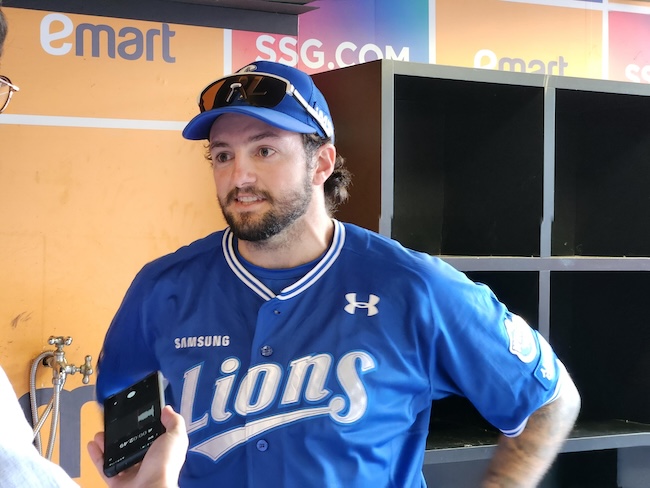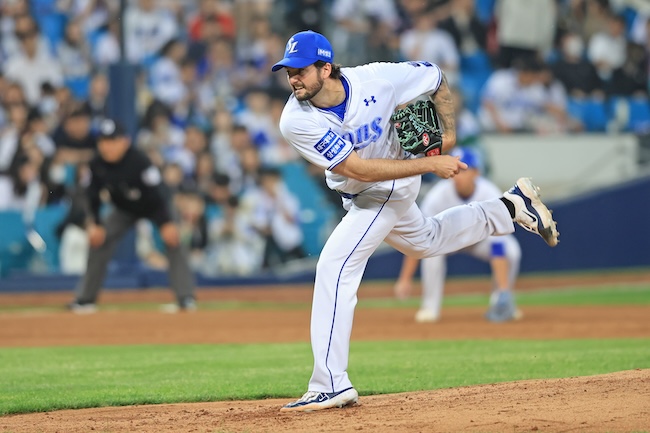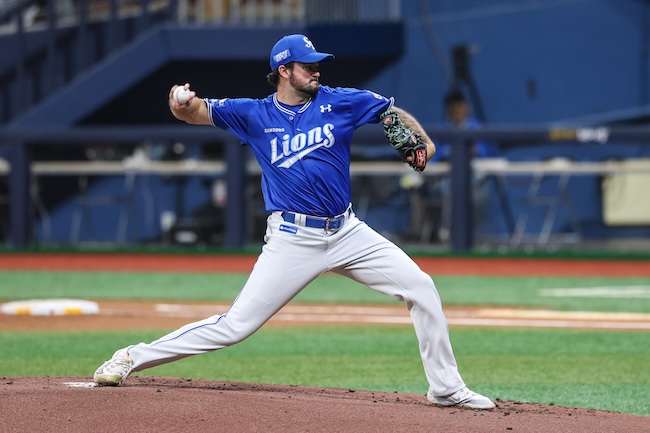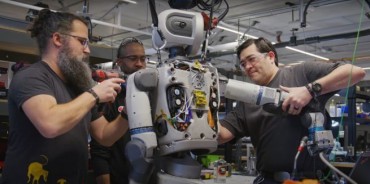
Samsung Lions starter Connor Seabold speaks with Yonhap News Agency at Incheon SSG Landers Field in Incheon, just west of Seoul, on May 14, 2024. (Image courtesy of Yonhap)
INCHEON, May 16 (Korea Bizwire) — Pitching well in his Korea Baseball Organization (KBO) debut might not have been such a good thing for Connor Seabold after all.
The American right-hander had the honor of starting on Opening Day for the Samsung Lions on March 23. He held the KT Wiz to two runs — one unearned — on four hits in six innings, and struck out eight.
It was a rock solid outing for the former major league pitcher, but in the back of his mind, Seabold had some apprehension.
“I cruised through that first one and didn’t really get to experience the KBO as it is,” Seabold told Yonhap News Agency on Tuesday, before the Lions took on the SSG Landers at Incheon SSG Landers Field in Incheon, just west of Seoul. “And so after that, it’s like, ‘Yeah, this is what it’s like pitching here.’ The next three, four starts weren’t great. In fact, they were pretty bad.”
Seabold wasn’t exactly being hard on himself. In five outings after his Opening Day game, Seabold was charged with 20 earned runs in 24 1/3 innings, for a 7.40 ERA.
Seabold finally threw his first scoreless game on April 27, when he held the Kiwoom Heroes off the board for five innings.

Samsung Lions starter Connor Seabold pitches against the Lotte Giants during a Korea Baseball Organization regular-season game at Daegu Samsung Lions Park in Daegu, 240 kilometers southeast of Seoul, on May 3, 2024, in this photo provided by the Lions. (Image courtesy of Yonhap)
Then in two May starts so far, Seabold has limited opponents to three earned runs in 10 innings while striking out 13.
That’s some progress, though his ERA for the season still sits at a not-so-great 4.76 after nine starts. And Seabold has not gone six innings since that Opening Day start.
“I’ve made some adjustments, kind of figured out what the pitch mix has got to be like,” he said. “I still need to go deeper into games. Overall I’m, I’m not satisfied but I’m happy with how it’s progressed.
Seabold said his second start, on March 29 against the Landers, was his “Welcome to the KBO” moment. He was roughed up for nine hits in five innings, including three home runs.
Seabold blamed himself for not learning more about KBO hitters earlier in the year and he’s getting better in that regard.
“I’m starting to learn the league. I’m starting to learn who’s who and kind of getting a better picture of how I need to pitch here,” he said. “I’m starting to know who I can strike out, who I can get soft contact against, who I’m going to have to get soft contact against. It’s just all part of the adjustment.”
Through his first nine starts, Seabold has faced seven different teams. And he has identified one common theme across the league.
“There’s a lot of scrappy at-bats,” he said. “There’s been plenty of times that I executed a pitch and there was either a really good swing or a really good take. And it’s like, ‘Wow, how did you not swing a bat at that?’ (I’m) trying to get used to it, like how the hitters are and which guys are going to do what. It’s very different than the States.”
Although he’s trying to make adjustments, Seabold isn’t about to undergo drastic changes to his arsenal, with the four-seam fastball and the slider being his two prominent pitches. He said he wants to get his changeup working as well as it did in the majors.
Seabold has been throwing the changeup 13.2 percent of the time, behind the four-seamer and the slider in his usage rate. And opposing hitters have batted .368 against that pitch, compared to a .296 mark against the fastball and a .197 average against the slider.

Samsung Lions starter Connor Seabold pitches against the Lotte Giants during a Korea Baseball Organization regular-season game at Daegu Samsung Lions Park in Daegu, 240 kilometers southeast of Seoul, on May 3, 2024, in this photo provided by the Lions. (Image courtesy of Yonhap)
In 27 games for the Colorado Rockies last year, Seabold also threw the changeup about 13 percent of the time. And it was his most effective pitch, as opponents only managed a .204 batting average and a .265 slugging percentage against it — by far the lowest marks in Seabold’s arsenal.
“I’m messing around a little bit with a splitter but not like anything crazy. Just something harder that’s going arm side that isn’t a changeup,” Seabold said. “My changeup hasn’t had the same results as it has in the States. I don’t have what has been my money pitch, working as a swing-and-miss pitch or even a soft-contact pitch. Those are the kind of adjustments, having to, on the fly potentially, come up with something new to fill the gap of what I’m missing.
“But you know, it’s a long season,” Seabold continued. “That stuff’s going to happen.”
Seabold said his execution of the changeup has left a lot to be desired, but also gave credit where it’s due, with KBO hitters making contact or taking a pitch.
“There’s been plenty of times where what could have been a swing-and-miss in the States was either contact or just a really good take,” he said. “Whether it’s guys just seeing it out of the hand a little bit better over here, or it could be ABS affecting a little bit, too. Who’s to say?”
Seabold was referring to the automated ball-strike system, which the KBO put in use for the first time this season. The ABS uses a tracking system to determine balls and strikes, and sends the call to the home plate umpire through an ear piece.

Samsung Lions starter Connor Seabold pitches against the Kiwoom Heroes during a Korea Baseball Organization regular-season game at Gocheok Sky Dome in Seoul on April 27, 2024, in this photo provided by the Lions. (Image courtesy of Yonhap)
Pitchers and hitters alike have complained about the ABS zone, which has been different from the zone called by human eyes until last year. But the KBO has countered with numbers that it claims prove the system’s accuracy and consistency.
Seabold, who had some experience with the ABS while pitching in Triple-A last year, said the zone is “a little different here” and that presents another area of adjustments for him.
Seabold said he had spoken with other foreign pitchers with more KBO experience and they all agreed that certain hitters with good plate discipline stand to benefit from the ABS.
“Now that the zone is enforced, they’re not going to swing at the ball that’s way outside anymore,” Seabold said. “In the States, I feel like I was pretty good at throwing the ball just off the outside corner. You don’t really get that here. So again, it’s just part of the adjustment.”
(Yonhap)






